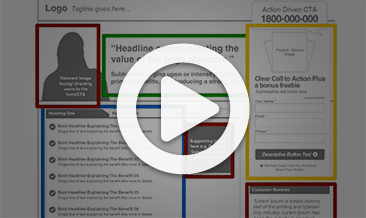
What’s the ideal lead management dashboard for keeping track of lead generation and sales activity?
Ever since we started, our focus has been on online lead generation – but it didn’t take long before the realisation hit that nothing happens until a sale is made.
All the leads in the world mean nothing until they convert into new cash, customers and profits.
And because we work remotely from our clients, to really see what’s happening on the coalface, we’ve needed to develop complete lead and sales management systems that provide full visibility of the entire revenue generation function.
And there are 5 functions to this system you need to have in place in order to continuously improve results.
They are:
- A lead generation function: marketing campaigns that draw qualified prospects to you on a steady and consistent basis.
- A lead management function: a process for effectively managing the leads you get and plugging them into your sales process. You need to ensure unqualified leads don’t unnecessarily consume your salespeople’s time – and also that good leads don’t get dropped.
- A sales process: a series of defined stages that prospects go through in order to become your client.
- Sales scripts: structured language designed to achieve the best sales outcomes (without appearing “wooden” or unnatural).
- A sales management function: this includes the visibility you need to monitor what you’re getting, warn you when things are off track, and report on outcomes and progress.
Today I’m going to share with you some of the sales management tools we’ve developed to help ensure your sales process remains on track.
Part 1: The Ideal Lead And Sales Management Dashboard
Here’s the lead and sales management dashboard we use to monitor the health of our sales and marketing pipeline.
(We use Infusionsoft – although the same concepts could be set up in most CRM dashboards if you happen to use a different tool.)
Below I’ll unpack why each box exists and what it achieves.
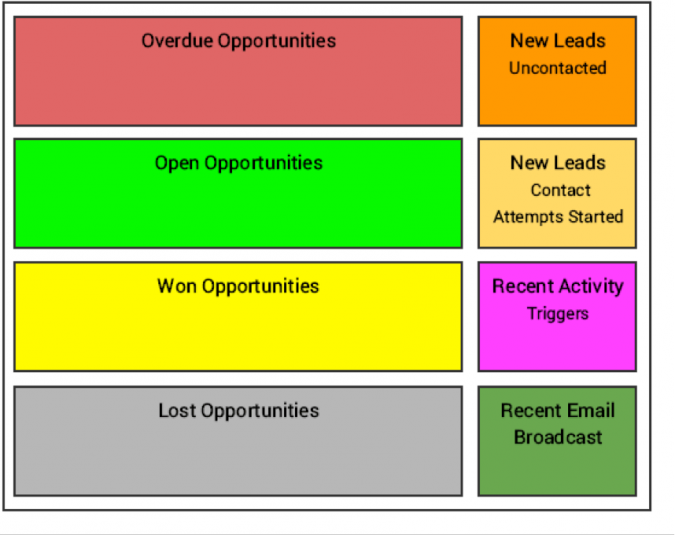
1. New Leads – Uncontacted
New Leads – Uncontacted contains a list of all the people who have contacted us whom we have not yet attempted to call to set up an appointment.
Because we aim to call back leads who may look qualified extremely quickly, at all times we want this box to look like this – empty!

If at any time there are leads in that box (during business hours), we aim to pounce on them.
We also keep a timestamp to record our actual callback speed – and work internally to improve our performance.
2. New Leads – Contact Attempts Started
This box contains a list of all the new leads that we have attempted to contact at least once. They’re in process.
We’ll attempt to contact these leads 6 times via phone and/or email before marketing them as “uncontactable”.
Our aim is to establish real-time contact via phone to determine what happens next.
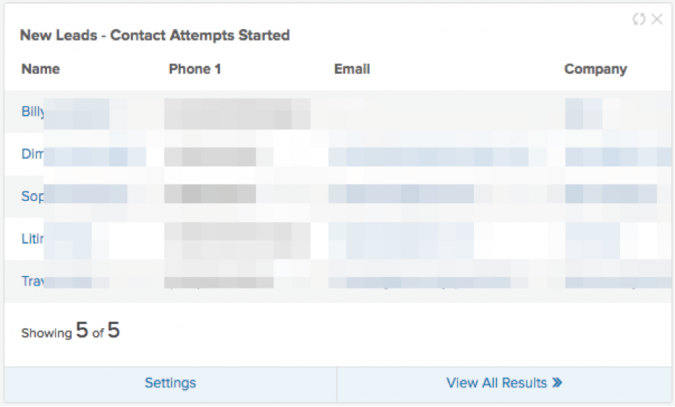
3. Open Opportunities
This is where the magic happens 🙂
We use a pipeline approach to managing opportunities, and the Open Opportunities tracks every current live opportunity and what stage it is at.
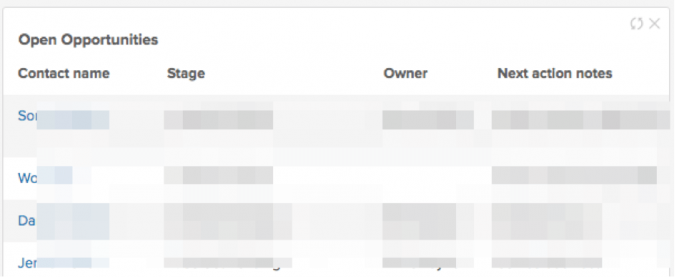
We can easily see at a glance, who we’re talking to, what stage they’re in, who owns the opportunity, the Next Action – and the Next Action Date.
These last two are critical.
Especially as your sales opportunity volume climbs, it’s vital that for every opportunity you know what’s going to happen next and when it has to happen by.
Providing these fields are constantly kept up to date, you’ll always have forward momentum in your sales pipeline.
This brings us to…
4. Overdue Opportunities
I’ve seen many companies have the best intentions to establish a wonderful sales process with documented pipeline steps and the whole nine yards – but they fall down on execution.
Even if you’re the sole salesperson (but especially if you have multiple salespeople) – you need an easily visible “warning light” to tell you when sales opportunities go off track.
The way we do this is with the “Overdue Opportunities” view. This shows us the moment an opportunity has a “Next Action Date” that is in the past.
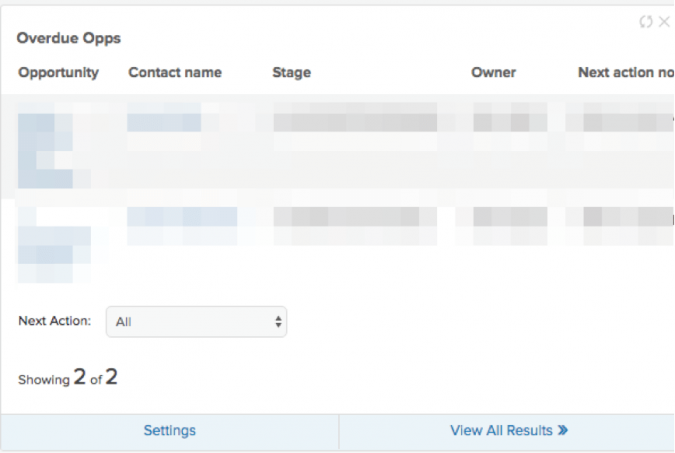
This provides a simple mechanism to ensure we:
- Always remember to update the opportunity with a “Next Action” and;
- Get a reminder to implement any “Next Actions” that get missed
This allows salespeople to self-regulate in most cases, but it also allows sales managers to remain more focused on only the items that are “off track”, rather than having to stay across every sales opportunity.
5 and 6. Won and Lost Opportunities
I find it useful to keep Won and Lost Opportunities within easy viewing reach. I can quickly see where we Won and Lost (and why), so if I have to access an opportunity from the recent past, I can.
7. Recent Activity
Infusionsoft has a widget called “Recent Activity” that can be useful for reading the “heartbeat” of our subscribers, leads and opportunities in real time.
Here’s what this looks like right now:
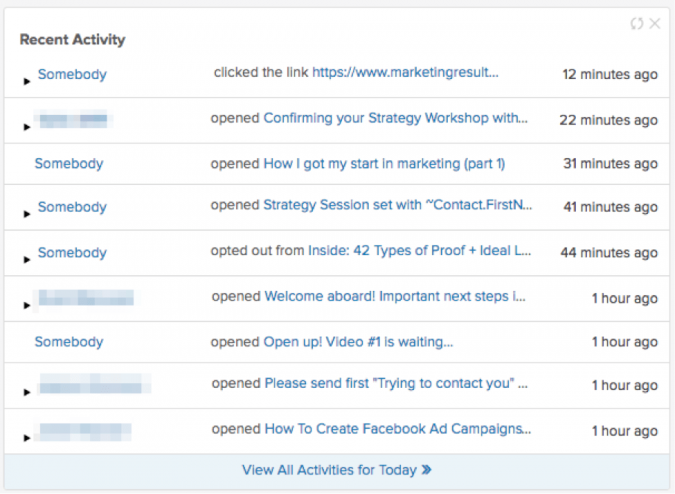
These “triggers” allow us to see with a quick scan, what individuals in our database are doing.
It can be useful to see if key emails were opened, or if individuals are interested in a particular topic or resource.
This allows our phone calls to be better timed and more relevant.
8. Recent Email Broadcasts
Zooming out to a more “macro” level, I like to see at a glance the results of recent email broadcasts. Infusionsoft has a ready-made widget that does this:
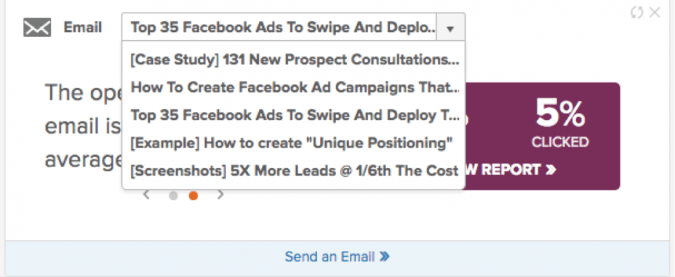
This allows me to see which emails and topics are getting more interest than others.
The above dashboard is something I’ve tweaked and refined over several years.
It works – and is easy to change up if I decide I want to see something else.
Most importantly, it allows us to manage and keep track of a complex, high volume pipeline quickly and easily, and ensure that leads don’t slip through the cracks.
A dashboard like this is great for tracking your real time activity – but it’s not great for getting a feel for the trends and performance of your sales function as a whole.
For that, you need a sales reporting process…
Part 2: The Ideal Lead And Sales Report
Keeping your sales function ticking over smoothly is all-important – but it’s not the whole picture.
Here’s an example to illustrate: a lot of CRM systems will produce a “Pipeline Report” that tells you how many sales opportunities are in what stage of the process, like this (fictional) report courtesy of Infusionsoft:
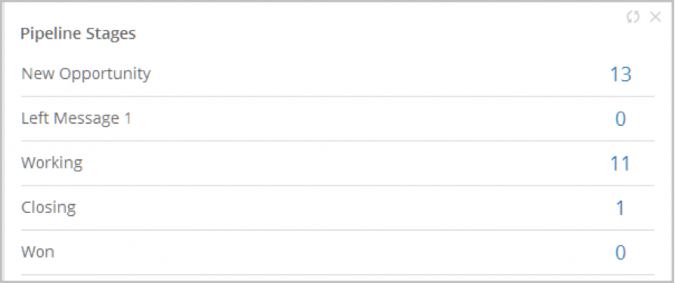
The real problem with reports like this is that it is only a static snapshot.
This doesn’t tell me critical information like:
- how fast opportunities are flowing through my pipeline
- how close I am to making my next sale(s)
- whether or not the sales function is getting more or less effective
- which pieces of the process need the most focus and improvement
- whether or not we’re on track to hit our targets
For that, you need a sales report.
Here’s the structure we use for ours:

We use Google Docs for this, and the report is compiled semi-automatically each week by our Sales Co-ordinator.
Let’s unpack this in more detail:
Weekly Views – this allows us to get a sense for the “flow” of opportunities through our pipeline every week.
One of our clients once had around 80 opportunities in the “Ready To Proceed” stage of their sales process. It looked good on paper – but when we started to use a report like the one above, we saw that very little were actually crossing over into a “Won” opportunity.
What they actually had, was a number of dead opportunities in their pipeline that they refused to pronounce last rites over. A report like the one above picks this sort of thing up.
List – this is the number of new subscribers joining our email list. While not a “sales” metric, per se, this is a great leading indicator of future sales enquiries and opportunities.
If this number drops, it may indicate that our enquiry pipeline will dry up in the near future
Enquiries – this is the number of raw sales enquiries coming in every week, via email or phone.
Appt Set – this is the number of Initial Appointments set – and the following column, Appt Set % – tracks the percentage of Enquiries converted into an appointment. This percentage gives a rough sense of lead quality and/or may flag issues around lead response times.
Appt Held – as you know, some appointments that are set are never held. They may be cancelled, or result in a no show, or similar. Nothing really happens until the appointment is held, so this number is critical.
FU Booked means “Followup Appointments Booked” – the number of initial appointments that result in a continuation of the opportunity. This provides a rough indicator of lead quality. If this number falls, that may suggest issues with either sales effectiveness (process, scripting), or lack of pre-qualification of certain opportunities in the pipeline.
Won – my second favourite column. The number of discrete opportunities won during the week.
New Rev – my all-time fave. The amount of new revenue generated during the week.
You’ll notice certain columns are further highlighted in aqua. These are the MOST CRITICAL numbers I like to keep track of very closely:
- Number of new subscribers
- The number of appointments with new prospects
- Number of deals closed and revenue generated
If these numbers are looking healthy, the sales function will be healthy.
How do your sales management processes stack up?
Where we’ve implemented sales re-engineering projects for our clients, they’ve usually seen a significant uptick in revenue and also reduced management time spent monitoring and improving the sales function.
Contact us if you know this is an area where you have potential and want to get a sense of the upside in terms of increased revenue, profit and reduced costs.
